-
NASA's Curiosity Rover Lands Aug. 5
August 5th -- the Mars Curiosity rover — the $2.5 billion, six-wheeled lab that’s the latest brainchild of NASA’s Jet Propulsion Laboratory (JPL) in Pasadena — is scheduled to touch down on the Red Planet. The landing will be like nothing NASA has ever attempted.Previous rovers (Sojourner, Spirit and Opportunity) have parachuted to the surface and then dropped the last bit encased in inflatable balloons. The Curiosity rover is just too big -- the size of a small car. So for this descent, engineers designed a shell that will fire rockets and then act as a sky crane to gently lower the rover to the ground. It takes 7 minutes to make the descent. But since it takes 14 minutes for radio signals to get back to Earth, by the time scientists learn that the rover has hit the atmosphere, it will already be on the ground. Engineers refer to this communications blackout as their ... "7 Minutes of Terror."
Curiosity weighs in at a hefty 5,293 lbs. (2,400 kg) and when it slams into the Martian atmosphere it will be traveling at a blistering 13,000 mph (21,000 k/h). When the ship is about 7 mi. (11 km) above the surface and traveling 900 mph (1,448 k/h), it's 51 ft. in diameter parachute will open and slow it down to 190 mph. Then the rocket sled will take over and lower the rover gently to the ground.
31 July 2012
MrC -
Boat Races -- Tuesday, June 5th
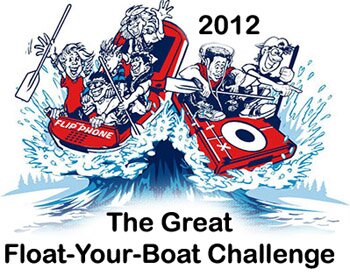
Sixth grade students have been studying density and buoyancy in their Earth Science classes.
They were challenged to create a “boat” out of recycled plastic bottles that would float one or two of their team.
Twenty-one boats ranging from kickboards to surfboards, rafts to miniature islands, and canoes to rowboats are now ready to race down the length of the Chadwick pool Tuesday, June 5th at 1:00 pm.
This is your invitation to come and watch the fun. In addition to students and their families and friends, the event is open to Chadwick faculty and staff as well as other Village, Middle School, and Upper School classes at Chadwick.
02 June 2012
MrC -
Earth Day -- 2012
April 22 will mark Earth Day worldwide, an event now in its 42nd year and observed in 175 countries.
The original grass-roots environmental action helped spur the Clean Water Act and Clean Air Act in the United States. Gathered here are 35 images of our planet's environment, efforts to utilize renewable alternative sources of energy, and the effects of different forms of pollution.
-- Lane Turner and Leanne Burden Seidel (35 photos total)
22 April 2012
MrC -
Amazing Photos of the Sun
Click on the picture above or this LINK to go to a Time Magazine photo gallery of recent pictures taken by NASA of solar flares on the sun. Amazing!
In this picture coronal loops extend some 60,000 miles away from the surface of the sun. The arches begin to form when plasma heats up and crashes down. Some scientists calculate that coronal temperatures may be 300 times hotter than the surface of the sun.
NASA has a great web site with VIDEOS showing sunspot activity.10 March 2012
MrC -
Rube Goldberg Machine
You have to watch this video! It is so cool!A "Rube Goldberg" machine is one that is made of odd parts and presents a sequence of activities that would not normally be connected.
All it takes is the push of a toy car to get everything started and then it moves along all by itself -- powered only by gravity and some occasional electric power. This sequence is brilliant! It's a great lead-in to our Bottle Rocket Project and introduction to physics.
15 Nov 2011
MrC -
Visit the California Science Center
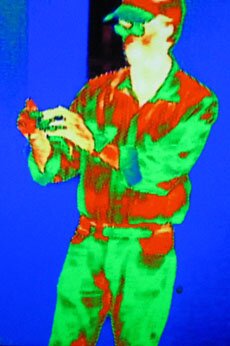 Yes, this is so cool! You just have to visit the California Science Center in downtown LA.
Yes, this is so cool! You just have to visit the California Science Center in downtown LA.Once you get there go straight to the ECOSYSTEMS exhibit and look for the Desert display. You'll see a camera on a pedestal that you can control with a joy stick. Move the camera around until it is pointing at YOU! Then, you'll see what you look like in INFRARED light!
This picture is Mr. Clauset taking a picture of himself from the LCD display in front of him. (Note: Infrared is your "heat signature" -- what you look like emitting heat.) White is the warmest temperature. Red is getting cooler... and green is next. Blue would be even cooler and black is coldest of all.
There are several lizards in the enclosure in front of you that you can focus the camera on -- they show up as GREEN -- meaning, pretty cool... unlike your skin which is WHITE and HOT!
6 Nov 2010
MrC -
Earth Science Study
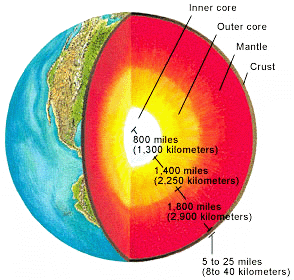 After our CIMI study unit on Kelp Forests students learn about the layers of the Earth and tectonic plates.
After our CIMI study unit on Kelp Forests students learn about the layers of the Earth and tectonic plates.Seismic waves are introduced and investigations are revealed on s-waves and p-waves, properties of the inner and outer core, as well as the unusual properties of the planet's crust.
It's all about density -- heavier rock like basalt lines the oceans' floor, while lighter granite fills the continental land masses. Next we take a look at tectonic plates, plate boundaries, and the more common fault types.
For a first major lab dealing with tectonic plates, we look at bathymetric maps and attempt to plot the boundaries of tectonic plates using the locations of earthquakes, volcanoes, mid-ocean ridges, and ocean trenches. Finally, we reconstruct the super-continent Pangaea of 245 million years ago.
10 Oct 2010
MrC -
Mr. Clauset Gives Presentation at National Gifted Conference

Mr. C. traveled to Charlotte, NC in early November, 2006 to give a presentation at the National Association for Gifted Children Conference.His session was titled, "An Inquiry Approach to Science Instruction for Middle School Students." With a cooler of dry ice that he had brought to the session, Mr. C. introduced workshop participants to a series of fun and challenging activities involving the mysterious properties of frozen carbon dioxide, better known as "Dry Ice."
Film canisters exploded, balloons inflated, candles were snuffed out, beakers erupted with fog, and mountains of bubbles cascaded out of containers.
Key questions were: 1) Why is this happening? and 2) What does this tell us about carbon dioxide? Workshop participants thought the workshop was excellent and were curious as well about other great 7th grade gifted education projects and labs including bottle rockets, balloon poppers, a marine biology trip to the Florida Keys, and end-of-the-year computer multi-media projects.
15 Nov 2006
MrC -
How Difficult Is It to Land on Mars?
When the rover enters Mars' atmosphere it will be traveling at 13,000 miles per hour. It has 7 minutes to decelerate to 0 mph at landing.Here is what the rover has to do to succeed:
1. Hit the atmosphere at just the right angle.
2. Endure extreme heat as it descends through the atmosphere.
3. Open its parachute at just the right time.
4. Use radar to know how high it is.
5. Free itself from the parachute.
6. Perfectly fire 8 rocket engines to slow its descent.
7. Drop down on 4 cables.
8. Lock its wheels before landing.
9. Cut the cables at the right moment of touch down.
-
NASA's Curiosity Rover
-
Boat Races
-
Earth Day 2012
-
Amazing Photos of the Sun
-
Rube Goldberg Machine
-
Visit the CA Science Center
-
Earth Science Study
-
MrC Gives Presentation
-
Landing on Mars
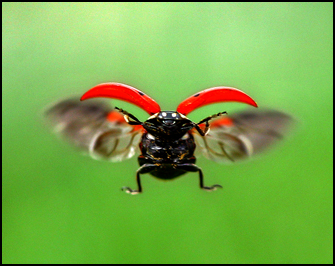
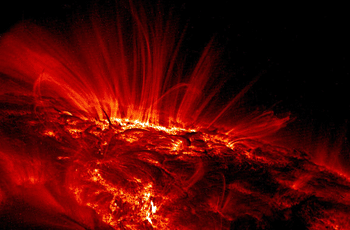
 Click on the image or the link below to send an email to MrC at
Click on the image or the link below to send an email to MrC at